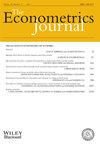GARCH时间序列参数变化历元的检验
IF 7
4区 经济学
Q1 ECONOMICS
引用次数: 0
摘要
我们开发了一种统一的测试来检测和确定严格平稳广义自回归条件异方差(GARCH)过程的综合或轻度爆炸行为。也就是说,我们检验了具有恒定参数的全局稳定GARCH过程的零假设,而不是存在参数值变化的“异常”时期的替代方案。在此期间,参数值的变化可能导致挥发过程的综合或轻度爆炸行为。假定地震的震级和时间都是未知的。我们提出了一个关于断裂是否存在的双至上检验,然后给出了一个识别变化周期的算法。我们的理论结果在GARCH过程创新的温和矩假设下成立。从技术上讲,GARCH模型中拟极大似然估计的现有性质需要重新研究,以便在所有可能的变化期间保持一致。关键结果涉及估计参数的一致弱Bahadur表示,这导致检验统计量弱收敛到高斯过程的极限。附录中的模拟表明,该测试在相当长的时间序列中具有良好的尺寸和功率。我们将该测试应用于金融市场和新兴金融科技市场代表的传统预警指标,即比特币收益。本文章由计算机程序翻译,如有差异,请以英文原文为准。
Testing for parameter change epochs in GARCH time series
Summary We develop a uniform test for detecting and dating the integrated or mildly explosive behaviour of a strictly stationary generalized autoregressive conditional heteroskedasticity (GARCH) process. Namely, we test the null hypothesis of a globally stable GARCH process with constant parameters against the alternative that there is an ‘abnormal’ period with changed parameter values. During this period, the parameter-value change may lead to an integrated or mildly explosive behaviour of the volatility process. It is assumed that both the magnitude and the timing of the breaks are unknown. We develop a double-supreme test for the existence of breaks, and then provide an algorithm to identify the periods of changes. Our theoretical results hold under mild moment assumptions on the innovations of the GARCH process. Technically, the existing properties for the quasi-maximum likelihood estimation in the GARCH model need to be reinvestigated to hold uniformly over all possible periods of change. The key results involve a uniform weak Bahadur representation for the estimated parameters, which leads to weak convergence of the test statistic to the supreme of a Gaussian process. Simulations in the Appendix show that the test has good size and power for reasonably long time series. We apply the test to the conventional early-warning indicators of both the financial market and a representative of the emerging Fintech market, i.e., the Bitcoin returns.
求助全文
通过发布文献求助,成功后即可免费获取论文全文。
去求助
来源期刊

Econometrics Journal
管理科学-数学跨学科应用
CiteScore
4.20
自引率
5.30%
发文量
25
审稿时长
>12 weeks
期刊介绍:
The Econometrics Journal was established in 1998 by the Royal Economic Society with the aim of creating a top international field journal for the publication of econometric research with a standard of intellectual rigour and academic standing similar to those of the pre-existing top field journals in econometrics. The Econometrics Journal is committed to publishing first-class papers in macro-, micro- and financial econometrics. It is a general journal for econometric research open to all areas of econometrics, whether applied, computational, methodological or theoretical contributions.
 求助内容:
求助内容: 应助结果提醒方式:
应助结果提醒方式:


